The 86-year-old had to postpone the trip last year after suffering knee problems. But he was determined to undertake the visit, which will bring to 10 the number of African countries he has visited.
We take a look at previous papal visits to the continent.
Pope Paul VI
1960: Uganda
In the 1960s, popes didn’t travel much outside Vatican City. Pope Paul VI bucked the trend and became the first reigning pope to visit Africa.
It was a major event when he visited Uganda in 1969. Among other activities, Paul VI made a pilgrimage to the Uganda Martyrs Shrine Namugongo. During his visit, twenty-two Catholic martyrs were canonised.
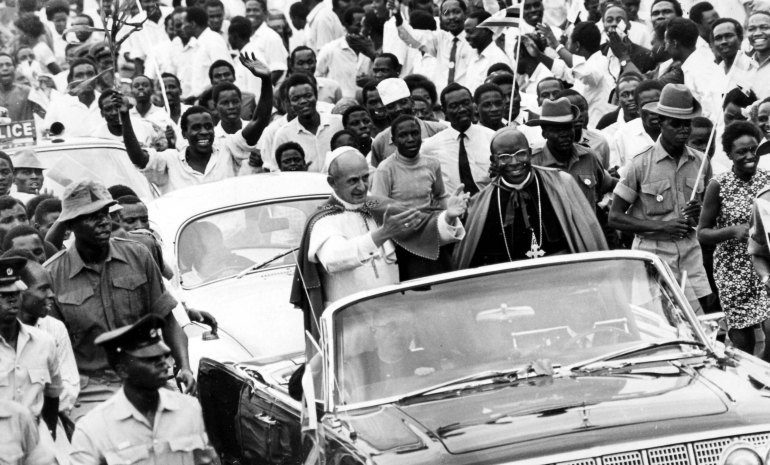
Pope John Paul II
Pope John Paul II travelled widely throughout Africa during his more than 26-year pontificate. His first tour was in 1980.
1980: The Democratic Republic of the Congo, the Republic of the Congo, Kenya, Ghana, Burkina Faso, and Ivory Coast
During his first African tour, he visited six countries in 11 days. At the time the Democratic Republic of the Congo was known as Zaire and Burkina Faso was known as Upper Volta.
In Ouagadougou, the capital of Upper Volta, he made an appeal for international assistance for the country as it suffered a devastating drought. The donations received set in place the foundations for the establishment of the John Paul II Foundation for the Sahel in 1984.
During his trip, he reportedly criticised Marxism as an ideology and welcomed the religious enthusiasm he encountered.
On his last day, he also said: “There is a great temptation to demolish instead of building, to procure weapons at a great price for populations that need bread, to want to seize power – sometimes confronting one ethnic group with another … while the poor sigh for peace, succumb to the desire for profit benefitting a privileged class.”

1982: Nigeria, Benin, Gabon, and Equatorial Guinea
John Paul II’s second tour took place in February 1982, nine months after an attempt on his life.
In Benin where church-state relations were rocky, he listened as President Matthieu Kerekou delivered a lecture on ‘the socialist struggle’, according to the UPI news agency. He then celebrated mass for approximately 20,000 people at the stadium in Cotonou.
After five days in five Nigerian cities, including Lagos and Onitsha, the pope said the visit left him with “‘an unforgettable memory of a country which is a credit to Africa, to the world and to the church of Jesus Christ”.
In the northern city of Kaduna, he called for unity at a gathering of Muslim religious leaders, saying: “All of us, Christians and Muslims, live under the sun of the one merciful God.”
He also
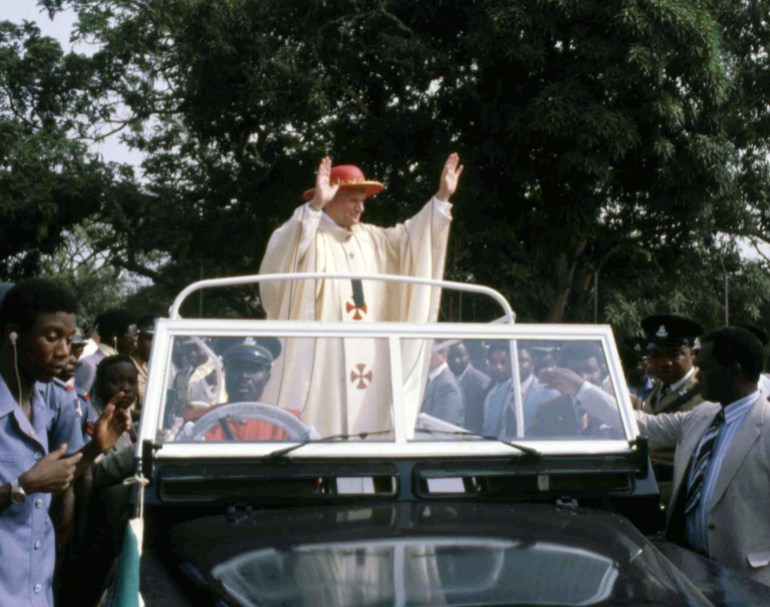
1985: Togo, Ivory Coast, Cameroon, Central African Republic, Democratic Republic of the Congo, Kenya, Morocco
This third tour of Africa was in August 1985, and his 27th trip outside Italy.
During this tour, he dedicated the biggest church in the world, the Basilica of Our Lady of Peace in Yamoussoukro, the capital of Ivory Coast. During his visit to the country five years earlier, he had blessed the foundation stone as construction began.
In a homily in Lome, the Togolese capital, he said he wanted to preach a faith that was ”authentically Christian and authentically African” in response to the matter of Catholicism adapting to traditional African practices.
He ended the tour with a plea to Muslims and Christians to put aside their differences and work together to create a better world.
1988: Zimbabwe, Botswana, Lesotho, Eswatini, Mozambique
During this trip, Pope John Paul II arrived in the Kingdom of Lesotho before a bloody shootout between police and gunmen who hijacked a busload of nuns and children while demanding to see the pope.
The pope arrived in Lesotho eight hours behind schedule and just 20 minutes before the tense hostage drama was resolved. One hostage died and eleven others were wounded but the others were rescued.
According to reports, the religious leader condemned apartheid in South Africa during this trip – in Lesotho.
“A civilization of justice, peace and love mean recognition of the dignity of each human being,” he was quoted as saying. “It means each human being can exercise fundamental rights without restrictions or limitations supposedly justified by racial segregation or by social discrimination.”
He also visited eSwatini, then still known as Swaziland.
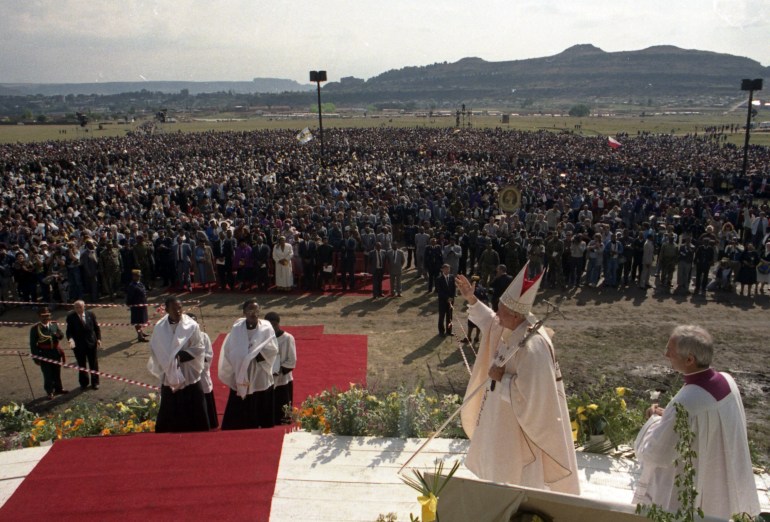
1989: Madagascar, Reunion, Zambia, Malawi
This was his fifth trip to Africa as a Pope and his 41st trip outside Italy.
According to reports, his interest in Africa was driven largely by the rapid expansion of the Church during those years. Vatican sources said the church gained 2.5 million new adherents in Africa in 1989 alone.
There was also the beatification of Victoria Rasoamanarivo – a member of the Malagasy elite who encouraged Catholica communities at a time when Christianity was outlawed in the country – as a saint in Antananarivo, Madagascar.
1990: Cape Verde, Guinea Bissau, Mali, Burkina Faso, Chad, Tanzania, Burundi, Rwanda, Ivory Coast
In 1990, John Paul II made two trips to Africa. In January that year, he went to Cape Verde, Guinea Bissau, Mali, Burkina Faso, and Chad.
In September, he travelled to Tanzania, Burundi, Rwanda and Ivory Coast.
In Tanzania, where one million of its 24 million people were living with AIDS, the pope stressed the need for a ”supreme effort of cooperation among governments as well as the scientific and medical communities”.
1992: Senegal, Gambia, Guinea, Angola
This was his 8th tour of Africa.
His visit to Angola coincided with the 500th anniversary of the coming of Christianity to the Central African country.
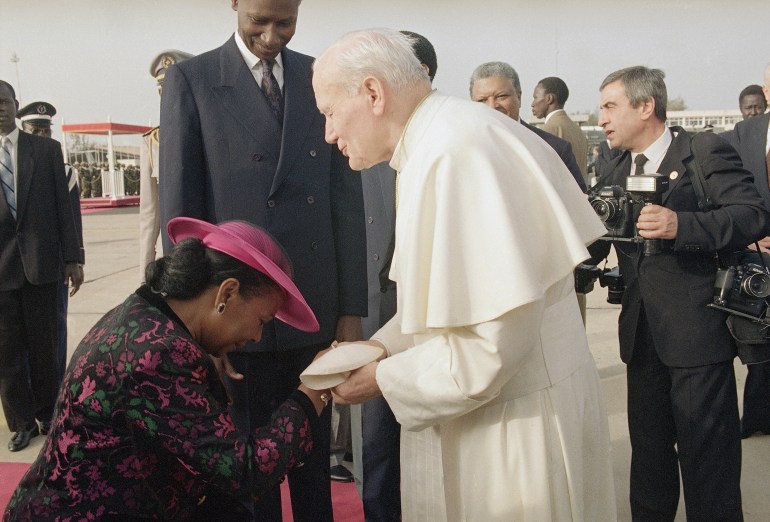
1993: Benin, Uganda, Sudan
During his 9th tour to Africa, John Paul II said the Vatican would strongly resist the imposition of Islamic law on Christians in Sudan.
“You absolutely cannot impose this law on those of other faiths who are Christian,” the 72-year-old Pope told reporters, according to a report by the New York Times.
“The role of the church, the Holy See and the bishops is to remind leaders of Muslim countries that Islamic law can be applied only to the Muslim faithful,” he said.
1995: Cameroon, South Africa, Kenya
Catholics in South Africa will long remember the historic visit by Pope John Paul II.
A longstanding opponent of apartheid, the pope refused several invitations to visit South Africa. But this time, he was received by the late President Nelson Mandela, the country’s first Black president, who praised his stand against apartheid.
“Today my journey brings me to a new South Africa, a ‘rainbow nation,’ indicating the diversity of races, ethnic groups, languages and culture which characterise it,” the pope said.
1998: Nigeria
This was his last trip to sub-Saharan Africa at the age of 77.
During his trip, he encouraged human rights within the country which was then under the authoritarian rule of the late Sani Abacha.
“Respect for every human person, for his dignity and rights, must ever be the inspiration and guiding principle behind your efforts to increase democracy and strengthen the social fabric of your country,” he said in a mass in Abuja.
“The dignity of every human being, his inalienable fundamental rights, the inviolability of life, freedom and justice, the sense of solidarity and the rejection of discrimination: these must be the building blocks of a new and better Nigeria,” he added.
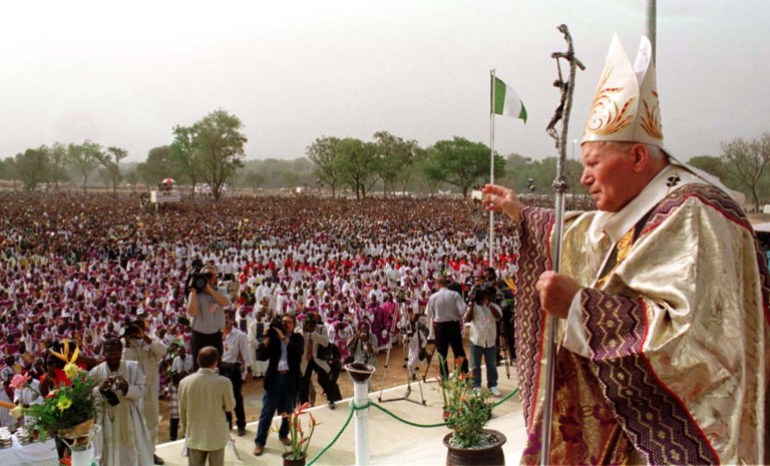
2000: Egypt
This trip was his first visit to the country.
The pope was greeted by Egyptian President Hosni Mubarak with a handshake at the foot of the plane’s stairs as he stepped onto the tarmac at Cairo International Airport.
A band played the processional from Verdi’s Aida, an opera associated with Egypt, as Mubarak then escorted the pope, leaning on a walking stick, to stand before the flags of Egypt and the Vatican.
“We never could have imagined that we would have the pope under our roof,″ said Samir Yassa, who designed the New Cathedral of Our Lady of Egypt where the pope met with Orthodox and Coptic clergymen in a display of their shared roots. “A brother is returning to a land where Christ walked.″
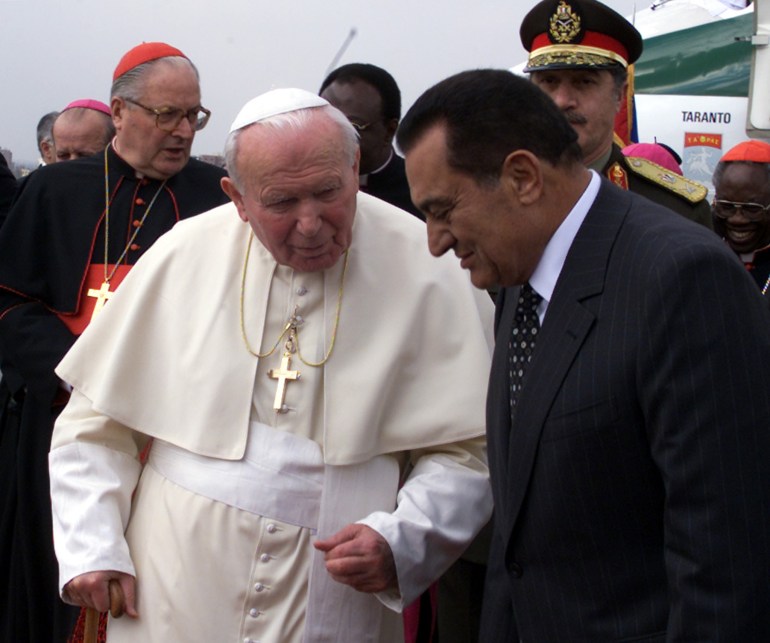
Pope Benedict XVI
2009: Cameroon, Angola
On Pope Benedict’s first trip to Africa, he urged Angolans, still recovering from nearly three decades of civil war in their oil-rich country, to build peace and understanding between peoples.
“Dear Angolans, your land is abundant, and your nation is mighty. Make use of these advantages to build peace and understanding between peoples,” the pope said.
“To this end, I ask you: do not yield to the law of the strongest! God has enabled human beings to fly, over and above their natural tendencies, on the wings of reason and faith.”
The Pope’s rejection of the use of condoms in the fight against HIV/AIDS sparked controversy during this trip.
2011: Benin
His last tour to Africa was a three-day visit to Benin at a time when the Catholic Church was growing faster than on any other continent.
At the end of 2011, the Catholic population worldwide reached 1.2 billion. According to America Magazine, there was a 4.1 percent increase in Catholics in Africa, twice the change in Asia, the second fastest-growing Catholic population globally.

Pope Francis
2015: Kenya, Uganda and Central African Republic
The Argentine-born pontiff made his first trip to Africa in November 2015, with a six-day visit to Kenya, Uganda and Central African Republic (CAR).
He brought with him a message of peace, social justice and dialogue with Islam on a trip that included a visit to a Nairobi slum and a mosque in the CAR capital Bangui.
In CAR, he urged warring factors to lay down their weapons and hailed Africa as “the continent of hope”.
2017: Egypt
In April 2017, Pope Francis paid a two-day visit to Cairo in support of the largest Christian community in the Middle East, the Coptic minority in Egypt, who have been subject to marginalisation and deadly attacks for years.
He also reached out to Islamic leaders, visiting Al Azhar, the centre of Sunni Muslim learning presided over by its grand imam, Ahmed al-Tayeb – one of Islam’s leading religious authorities.
2019: Morocco
At the invitation of King Mohammed VI, Francis visited the North African country of Morocco in March 2019.
His trip was marked by calls for religious tolerance, freedom of religion and also respect for the rights of refugees and migrants.
He also warned the Christian faithful against trying to convert others, preaching “no proselytism” ahead of a mass for thousands of Catholics in Rabat.
2019: Mozambique, Madagascar and Mauritius
In September 2019, the pope visited Mozambique and the Indian Ocean nations of Madagascar and Mauritius, again calling for peace and social justice.
In Madagascar, 30 years after the last papal visit made by John Paul II, Francis made an impassioned plea for the environmental protection of the island known for its immense diversity of flora and fauna.
